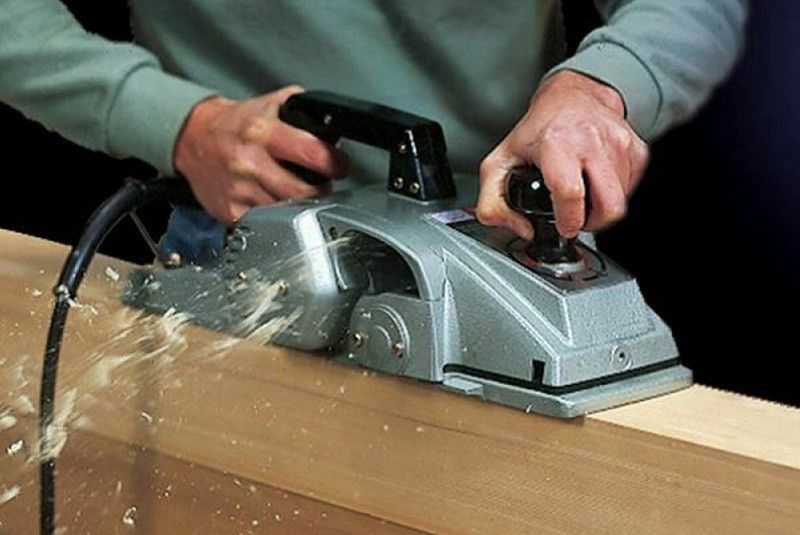Planer
What is a handheld planer? Should you invest in a handheld wood planer?
Handheld wood planers for those who do not know, this type of machine is popular in the wood industry, often used by carpenters to flatten and smooth the wood surface, increasing the aesthetics and finishing of the product. Thanks to the ability to handle quickly, neatly, and evenly, the machine helps workers save a significant amount of time compared to manual methods, while ensuring higher accuracy in each planing line.

Nowadays, the wood industry is growing strongly, especially furniture, decor, and handicraft products. Investing in a handheld wood planer not only helps you do your job well but also makes a worthy investment.
Safety notes when using a handheld wood planer
Extreme care must be taken when using a planer, as carelessness can cause serious accidents.
First, you need to read the manufacturer's instructions carefully before operating the machine. Each model may have its own structure or characteristics, so don't be subjective. You need to equip yourself with protective gear, especially dust goggles, masks, noise-canceling headphones and anti-slip gloves.

The working space is also kept neat and clean, with no obstacles near the machine operating area. Before starting to plan, you should carefully check the condition of the planer blade, machine base, power cord and switch, and avoid looseness.
Finally, to use the planer effectively, it is necessary to avoid mistakes when using the planer. Refer to some hot models available at EMIN:
Makita KP0800X (620W)
BOSCH GHO6500 hand planer
MAKTEC MT191 Planer (580W)
Summary of recent EMIN frequently asked questions

1. Can the planer handle hard wood like ironwood?
Lim wood is known to be a hard, heavy and oily wood, often causing difficulties with wood planing equipment. However, with planers with a capacity of 600W or more, planing lim wood will be easier. Models that can be mentioned are Makita KP0800X (620W), Bosch GHO 6500 (650W) and Stanley STPP7502 (750W), most of these models are equipped with alloy blades, high rotation speed and the ability to adjust the planing depth, can effectively handle hard woods such as lim.
However, when planing ironwood, users should divide the depth each time the machine is used, avoiding planing too hard, causing the machine to overheat and the blade to chip. At the same time, it is necessary to regularly check the condition of the planer blade to ensure efficiency.
2. Is the 540W machine powerful enough to plane a 3cm thick wood surface?
540W capacity is commonly found in common planers, suitable for processing thin wood, soft wood or making small details. For wood surfaces about 3cm thick, the 540W machine can completely handle it, but it needs to be run many times, each time planing with a small depth to ensure the machine is not sluggish, the blade is not overloaded.
3. Will using the planer frequently cause the knife to chip?
The risk of chipping when using a planer does not depend entirely on how often you use it, but largely on how you use it and the type of wood being worked. If you regularly plan hard wood, wood with knots or remaining nails or sand, the risk of chipping is very high, no matter how new the machine or how good the blade is.
On the contrary, if the user knows how to check the surface of the workpiece before planing, adjust the depth appropriately, and clean and maintain the machine properly, the knife can still last for a long time.
4. What kind of machine can plan wet wood?
In fact, most wood planers today are designed to plan dry wood. Wet wood has a high moisture content, which can easily clog the blade, jam the chips, making the machine sluggish and quickly damaging the blade. If you have to plan wet wood, you should choose a machine with high power (over 600W), high rotation speed, wide chip outlet and easy-to-remove, cleanable blade.
However, there is no machine that specializes in wet wood planing because the priority is still that the wood has been dried or dried. Wet wood planing is only a temporary solution, and if done regularly, users need to prepare replacement blades, clean the machine continuously and avoid overloading the machine or consider learning about industrial wood planers with larger capacity!
So in this article you know what a planer is and what to note when using a planer. You can see more at EMIN Hand Planer!
-
-
-
-
-
-
-
-
-
-
-
-
-
-
-
-
-
-
-
-
-
-
-
-
